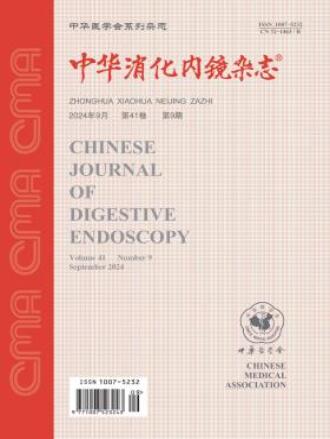早期食管癌内镜下粘膜下隧道完全切开后自体皮肤移植术预防食管狭窄的临床价值
引用次数: 0
摘要
目的探讨自体皮肤移植手术(ASGS)预防早期食管癌内镜下粘膜下隧道清扫术(ESTD)术后食管狭窄的疗效和安全性。方法2018年1月至2018年3月,解放军总医院5例早期食管癌患者行全循环ESTD和ASGS。内镜随访观察植皮存活情况、食管狭窄及并发症发生情况。结果5例患者均成功完成全循环ESTD和ASGS,无穿孔、出血、创面感染、支架移位等并发症发生。平均植皮成活率为86.0%。4例患者在平均9.5个月的随访中未出现食管狭窄。1例患者术后出现食管狭窄,行内镜球囊扩张术。随访8个月无狭窄发生。结论ASGS是预防完全性环形ESTD后食管狭窄安全有效的方法。关键词:食管狭窄;自体移植;功效;安全;早期食管癌;内镜下粘膜下隧道解剖本文章由计算机程序翻译,如有差异,请以英文原文为准。
Clinical value of autologous skin-grafting surgery to prevent esophageal stenosis after complete circular endoscopic submucosal tunnel dissection for early esophageal cancer
Objective
To assess the efficacy and safety of autologous skin-grafting surgery (ASGS) in the prevention of esophageal stenosis after complete circular endoscopic submucosal tunnel dissection (ESTD) for early esophageal cancer.
Methods
Between January 2018 and March 2018, five patients with early esophageal cancer underwent complete circular ESTD and ASGS in Chinese PLA General Hospital. The skin-graft survival situation, and occurrence of esophageal stenosis and complications were observed by endoscopy follow-up.
Results
Complete circular ESTD and ASGS were successfully performed in all 5 patients, and no complications including perforation, bleeding, wound infection or stent migration occurred. The mean skin-graft survival rate was 86.0%. Four patients did not experience esophageal stenosis over the mean follow-up of 9.5 months. One patient experienced esophageal stenosis after operation, and underwent endoscopic balloon dilatation.No stenosis occurred in 8 months of follow-up.
Conclusion
ASGS is a safe and effective method to prevent esophageal stenosis after complete circular ESTD
Key words:
Esophageal stenosis; Transplantation, autologous; Efficacy; Safety; Early esophageal cancer; Endoscopic submucosal tunnel dissection
求助全文
通过发布文献求助,成功后即可免费获取论文全文。
去求助
来源期刊
CiteScore
0.10
自引率
0.00%
发文量
7555
期刊介绍:
Chinese Journal of Digestive Endoscopy is a high-level medical academic journal specializing in digestive endoscopy, which was renamed Chinese Journal of Digestive Endoscopy in August 1996 from Endoscopy.
Chinese Journal of Digestive Endoscopy mainly reports the leading scientific research results of esophagoscopy, gastroscopy, duodenoscopy, choledochoscopy, laparoscopy, colorectoscopy, small enteroscopy, sigmoidoscopy, etc. and the progress of their equipments and technologies at home and abroad, as well as the clinical diagnosis and treatment experience.
The main columns are: treatises, abstracts of treatises, clinical reports, technical exchanges, special case reports and endoscopic complications.
The target readers are digestive system diseases and digestive endoscopy workers who are engaged in medical treatment, teaching and scientific research.
Chinese Journal of Digestive Endoscopy has been indexed by ISTIC, PKU, CSAD, WPRIM.

 求助内容:
求助内容: 应助结果提醒方式:
应助结果提醒方式:


